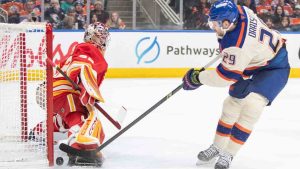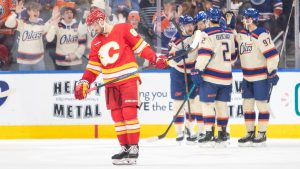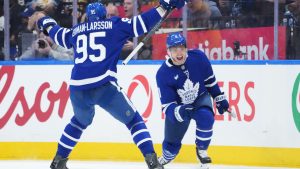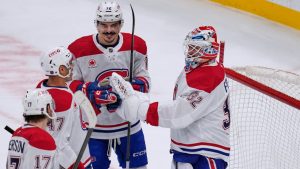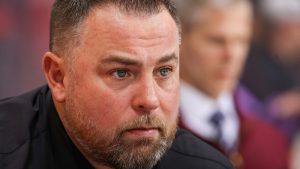EDMONTON — When it comes to acquiring Duncan Keith, you just don’t know. And anyone who says they do know — for sure, without an ounce of uncertainty — is full of Schlitz.
So there is an inherent element of gamble — no big scoop when you’re talking about acquiring a nearly 38-year-old defenceman with a $5.5-million cap hit.
This trade, should the Edmonton Oilers choose to make it, is about intangibles. It is not — we repeat, NOT — an analytics trade. Even if this Sportlogiq piece makes a favourable case of the numbers for Keith on a team where he can play secondary minutes.
When we look back on this deal two years from now — when an unrestricted free agent Keith is pushing 40 — we will know just how much Keith helped the Oilers in all those areas that our friends in the analytics community can not track. Those are intangibles that hockey people covet, but can also be responsible for acquiring players like Milan Lucic and Loui Eriksson with huge, untenable contracts.
The difference for Keith is, his minutes and on-ice responsibilities would decrease in Edmonton, an important distinction. And the areas that improve with age — leadership, teaching ability, helping younger players — would be a great part of his game.
He can still skate and he can still play. That is what all of my sources tell me.

What we will be projecting are these elements:
How much did young players like Ethan Bear, Evan Bouchard, Philip Broberg — perhaps even Dmitri Samorukov — glean from practising and playing with Keith? How much knowledge can he impart that makes them all better, faster?
On a team that has killed it in the regular season yet lost seven of its eight most recent playoff games, how much did Keith’s experience help Connor McDavid, Darnell Nurse, Leon Draisaitl and Adam Larsson (who will be signed) to figure out whatever it is that Winnipeg had in those overtime games that Edmonton did not?
Would Edmonton blow that 4-1 third period lead in Game 3 against Winnipeg with Keith on the ice more, and Bear less? Would they be a better team with Keith playing 20 minutes, and Nurse playing 24 rather than 28 minutes?
Are Oscar Klefbom’s chances of making a slower, more incremental return made better by having Keith as your second pairing left defenceman, ahead of Caleb Jones, Kris Russell or a Slater Koekkoek? And by playoff time, is Klefbom a greater asset because Keith bought him time?
I am answering “Yes” to all of those questions. And one more time: the people I talk to all indicate that Keith can still skate, and as such, can still play. On a second pairing with Larsson, we would like Keith’s analytics much, much more than the ones posted playing with (in order of minutes) Ian Mitchell, Adam Boqvist and Connor Murphy this past season, those voices add.
He is, very likely, a Hall of Fame defenceman and a retired number in Chicago. While the Oilers have most of what they need to become a Stanley Cup contender, adding Keith as their second left defenceman, and injecting all that he brings inside the culture being built here is a no-brainer, said Blackhawks radio analyst Troy Murray.
Murray grew as an Oilers fan in St. Albert, an Edmonton suburb, and has read the dissenting views on the Keith acquisition on-line. That Keith is the last thing Edmonton needs this off-season.
“The last thing you need?” Murray said. “If I’m Ken Holland, he’s the first thing you need. Not the last. The first thing.”
So for Oilers general manager, the gamble is about how much you give up for Keith. What level of prospect? How much salary can you negotiate for the Blackhawks to retain?
Could you trade a useful player/prospect to Chicago, along with goalie Mikko Koskinen? Edmonton could retain half of Koskinen’s salary and have Chicago buy the goalie out. That would leave both teams with a $750,000 cap hit for two seasons.
I would move Caleb Jones for Keith all day long. But would the Koskinen component turn Jones into a more valuable prospect?
[snippet id=4167285]
On the other side, Keith’s No Movement Clause puts him in charge of this trade. He wants out, and wishes to be nearer to his eight-year-old son Colton, who resides in Penticton. That leaves Chicago GM Stan Bowman with four trade partners: Vancouver, Calgary, Seattle and Edmonton.
Yet there is every chance that Vancouver does not have the cap space, and that Calgary is not interested with Mark Giordano already in the fold. Also, Keith may look at the expansion Kraken and refuse to join a team that is years away from Cup contention.
So, there is every chance that Bowman has one trading partner. Holland should be aware of that, and offer accordingly.
But Holland, who as a GM in Detroit acquired Chris Chelios at age 37, values the intangibles Keith would bring — both for his kids and his veterans. Remember, Holland also added Larry Murphy at age 36, Steve Duchesne (34), Luc Robitaille (35) and Igor Larionov (35), among others.
It worked, albeit in another time at another place. We think, given a reasonable acquisition price, that it would work in Edmonton in 2021 — knowing that it’s a two-year commitment, not five or six years. A place-holder for Philip Broberg, if you will.
“Who are the guys who will benefit the most from Keith? McDavid and Draisaitl,” said another exec we spoke to on Tuesday. “This guy’s competitive level is at a different place than most human beings. The work ethic he brings to every single game is where Edmonton has to get to.”
Three Stanley Cups, two Norris Trophies and a Conn Smythe.
Two years at $5.5 million on your AAV, but just $3.6 million in actual salary.
For the right price?
I’d do the deal.
[relatedlinks]
